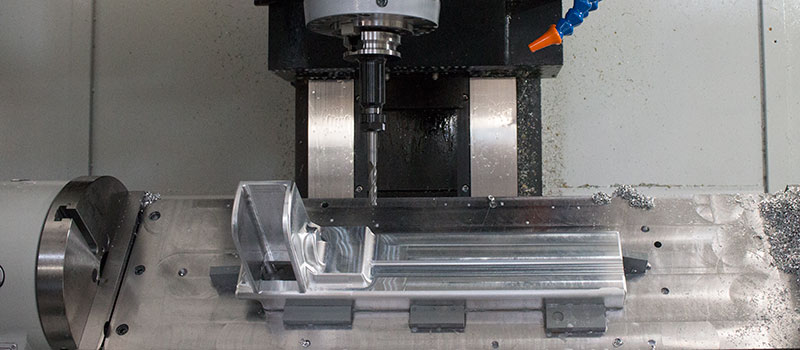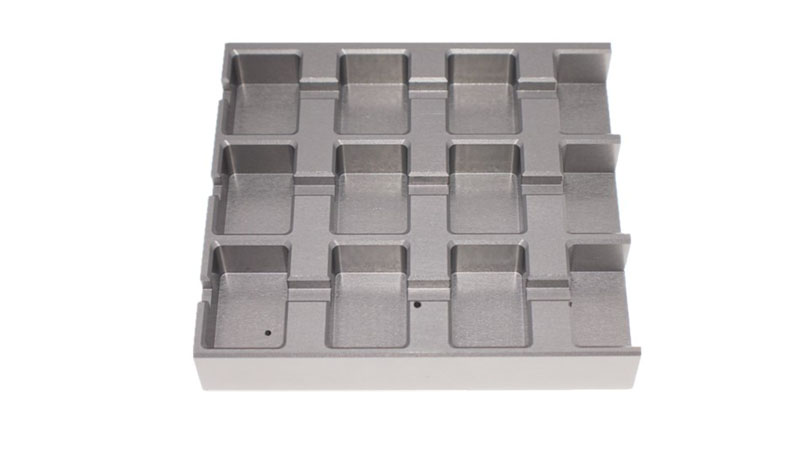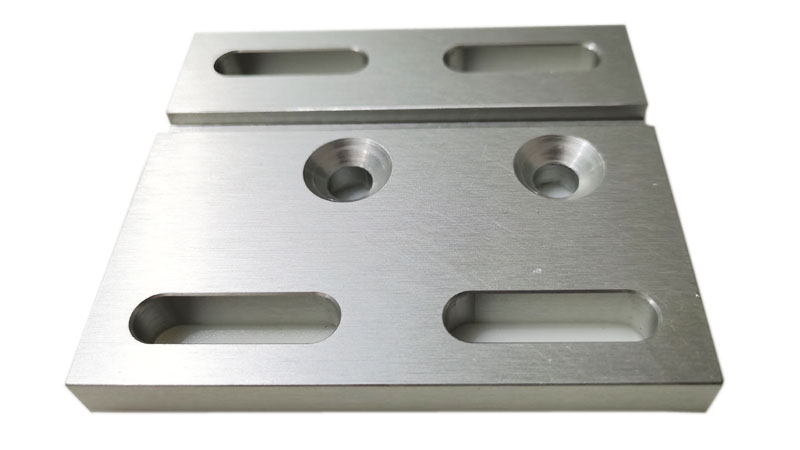Aluminum alloy is now used in many fields and is an essential raw material in the CNC machining industry. However, compared with other metals, it has low hardness and huge thermal expansion value, which makes the processing of aluminum alloy precision parts prone to product deformation. There are many reasons for the deformation of aluminum alloy precision parts, which are related to the material, production conditions, part shape and cutting fluid performance. Therefore, in order to reduce processing deformation, aluminum alloy precision parts machining manufacturers can take various measures and improve the process to achieve the purpose of reducing deformation. Here are several methods that can reduce the deformation of aluminum alloy parts in CNC machining. 
Reduce Internal Stress Of Aluminum Rough Parts
The internal stress of rough parts can be partially eliminated by natural or artificial aging and vibration treatment. Pretreatment is also an effective process. For larger rough aluminum parts, the deformation after machining is also great. If the excess aluminum material is cut from the blank part, precise tolerances can be obtained and deformation can be improved. After staying for a period of time, part of the internal pressure will also be released.
Improve The Cutting Ability Of Cutting Tools
The material and geometric parameters of cutting tools have an important influence on cutting force and heat. The correct selection of cutting tools is very important to reduce the machining deformation of the parts.
Geometric parameters that affect tool performance:
Front Angle:
The front angle must be configured correctly to maintain the strength of the blade, otherwise the sharp edges will wear. Under the condition of maintaining the strength of the edge, the rake angle should be appropriately large. On the one hand, it can grind sharp edges. On the other hand, it can reduce cutting deformation, make chips smoothly removed, and then reduce cutting force and cutting temperature. We do not recommend using negative rake angle tools.
Back Angle:
The size of the back angle directly affects the side wear and processing quality. The cutting thickness is an important parameter to be considered when configuring the back angle. In rough milling, due to the large feed rate, heavy cutting load and high heat output, the tool is required to have good heat dissipation conditions, so a smaller relief angle should be selected. In fine milling, sharp edges are required to reduce friction between the side and the machined surface and reduce elastic deformation. Therefore, a larger relief angle should be selected.
Helix Angle:
In order to make the milling smooth and reduce the milling force, the helix angle should be as large as possible.
Entering Angle:
Properly reducing the entering angle can improve the heat dissipation conditions and reduce the average temperature of the processing area.
Improve The Structure Of Cutting Tools
Reduce The Number Of Cutter Teeth And Increase The Chip Space.
Due to the large plasticity of aluminum material and the large cutting deformation during processing, a larger chip space is required. Therefore, the radius of the bottom of the chip flute should be larger, and the number of milling cutter teeth should be smaller.
The radius of the bottom of the tank should be larger, and the number of milling cutter teeth should be reduced. For example, two cutting teeth are used in a milling cutter of 20 mm or less, and three cutting teeth are used in a milling cutter of 30 to 60 mm to avoid deformation of aluminum alloy thin-walled parts due to chip clogging.
Precision Grinding Cutter Teeth
The roughness of the cutting edge is less than Ra = 0.4um. Before using a new cutting tool, gently rub the front and back surfaces of the cutting teeth with fine pitch to eliminate the burrs and fine serration marks left when grinding the cutting teeth. In this way, not only can the cutting heat be reduced, but the cutting deformation is relatively small.
Strictly Control Tool Wear Standards.
After the tool is worn, the surface roughness of the workpiece increases, the cutting temperature increases, and the deformation of the workpiece increases. Therefore, in addition to selecting tool materials with good wear resistance, the wear standard of the tool should not be greater than 0.2mm, otherwise it is easy to produce chip edges. When cutting by CNC milling or CNC turning, the temperature of the processed workpiece should not exceed 100°C to prevent deformation.
Improve The Clamping Method Of The Workpiece.
For thin-walled aluminum workpieces with poor rigidity, the following clamping methods can be used to reduce deformation:
For thin-wall CNC machining bushing parts, if a three-jaw self-centering chuck or spring chuck is used to clamp from the radial direction, once it is released after processing, the workpiece will inevitably deform. At this time, a method of pressing the axial end face with good rigidity should be used. According to the position of the inner hole of the part, a threaded mandrel is made to locate the inner hole of the part. Insert it into the inner hole of the part. The cover plate is used to compress the end face, and the nut is used to tighten backward. When machining the outer circle, clamping deformation can be avoided and satisfactory machining accuracy can be obtained.
In addition, filling methods can also be used. In order to improve the process rigidity of thin-walled workpieces, media can be filled in the workpiece to reduce the deformation of the workpiece during clamping and cutting. For example, pour a urea melt containing 3% to 6% potassium nitrate into the workpiece. After processing, immerse the workpiece in water or alcohol, and then dissolve the filler and pour it out.
Reasonably Arrange The Production Process
In high-speed cutting, due to large machining allowance and intermittent cutting, vibration often occurs during milling, which affects machining accuracy and surface roughness. Therefore, CNC high-speed cutting technology can generally be divided into rough machining, semi-finishing, corner cleaning and finishing. For parts that require high precision, sometimes it is necessary to perform a second semi-finishing first, and then finishing. After rough machining, the parts can be cooled naturally to eliminate internal stress and reduce deformation.
The remaining margin after rough machining should be greater than the deformation, usually 1-2 mm. During finishing, the surface of the part should be uniform. Generally, 0.2-0.5mm is the best way to keep the tool in a stable state during the finishing process, which can greatly reduce cutting deformation, obtain good surface processing quality and ensure product accuracy.
In addition to the above reasons, the operation method is also very important in actual operation, and the correct operation method can also greatly reduce the bending of aluminum alloy parts.
Symmetrical Machining
For aluminum parts with large machining allowances, excessive heat concentration must be avoided to produce better heat dissipation and reduce thermal deformation. Symmetrical machining can prevent excessive heat build-up around parts during machining. Therefore, it reduces the chance of thermal deformation.
Choose The Right Cutting Parameters
Choosing appropriate cutting parameters will reduce cutting heat and force. Cutting parameters higher than the normal value will cause excessive cutting force during aluminum CNC machining. Due to the large amount of heat generated, it is easy to cause deformation of the parts. Moreover, since the tool life impairs the rigidity of the spindle, the durability of the life is reduced.
Among all the factors of cutting parameters, the biggest influence on cutting force is the number of back cutting depths. However, although reducing the number of cutting tools helps to ensure that the parts are not deformed, it also reduces the processing efficiency. High-speed milling of CNC machining can solve this problem. By reducing the depth of aftercutting, increasing the feed rate and increasing the machine speed, machining can reduce the cutting force and ensure machining efficiency.
Machining In A Stratified Technique
When there are multiple cavities on the aluminum alloy parts, due to the uneven force, the sequential processing method of one cavity and one cavity is not suitable for processing, which will easily cause uneven force and deformation of the parts. Milling is carried out with a variety of layered processing methods, each layer is processed to all cavities at the same time, and then the next layer is processed to make the parts evenly stressed and reduce deformation. Compared with processing parts at one time, this option has less risk of part deformation. The earlier situation was that the force applied during aluminum CNC machining was more uniform.
Drilling And Milling
Machining parts with cavities has its own problems. If the milling cutter is directly applied to the part, the cutting will not be smooth due to insufficient chip space of the milling cutter. This leads to the accumulation of a large amount of cutting heat, expansion and deformation of parts, and even potential fracture of parts or tools.
The best way to solve this problem is to drill and then mill. This involves first drilling a hole with a tool no smaller than the milling cutter, and then placing the milling cutter in the hole to start milling.
Pay Attention To The Sequence Of Cutting Tool Walking Way.
Rough milling emphasizes the improvement of machining efficiency and the pursuit of cutting speed per unit time. Usually reverse milling can be used. In other words, the excess material on the surface of the blank is removed in the fastest speed and the shortest time, and the geometric contour required for finishing is basically formed. Precision machining emphasizes high precision and high quality, and it is recommended to use front milling. Because the cutting thickness of the cutting teeth gradually decreases from the maximum value to zero, the degree of hardening of the workpiece is greatly reduced, and the degree of deformation of the part is also reduced.
(All About Aluminum Machining Parts)


